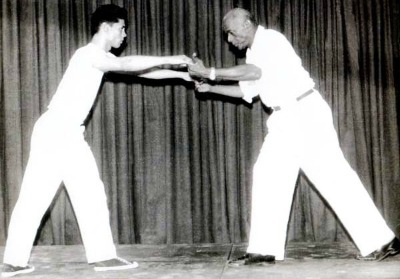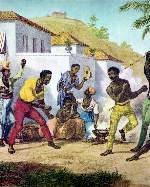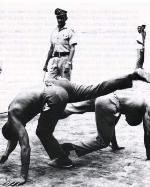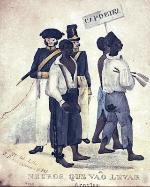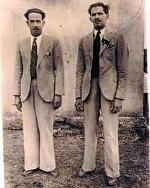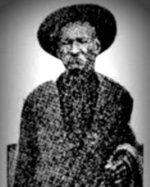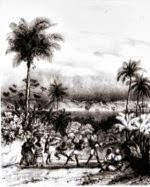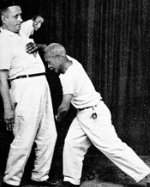Mestre Bimba and the Legalisation of Capoeira in Brazil
Talk the Talk
Bimba is a cute term for penis much like wee wee in English and is a nickname the Mestre had from when he was first born.
As he had a lot of puppy fat, the midwife thought he was a girl but his mother disagreed; when the midwife moved the fat out of the way, the nickname was born when she yelled,
As he had a lot of puppy fat, the midwife thought he was a girl but his mother disagreed; when the midwife moved the fat out of the way, the nickname was born when she yelled,
"He is a boy! Look at his Bimba."
Walk the Walk
Between 1918 and 1936, Mestre Bimba challenged all the best fighters he could find to test his Regional capoeira style.
Not only did he win each fight, but most were over very quickly; the longest, according to the great capoeirista himself, lasted just one minute and two seconds.
Not only did he win each fight, but most were over very quickly; the longest, according to the great capoeirista himself, lasted just one minute and two seconds.
Capoeira Quote
"There are two writers from Rio de Janeiro who say that capoeira came from Africa, but no. It was created in Brazil, in the slave quarters, on the plantations, where the blacks worked.
So that when they were pursued by the so-called “Captain of the Bush” [those sent to recapture runaway slaves], they defended themselves with kicks and sweeps.
In theory, that’s the legend of capoeira, which existed in 1918".
~ Mestre Bimba ~
So that when they were pursued by the so-called “Captain of the Bush” [those sent to recapture runaway slaves], they defended themselves with kicks and sweeps.
In theory, that’s the legend of capoeira, which existed in 1918".
~ Mestre Bimba ~
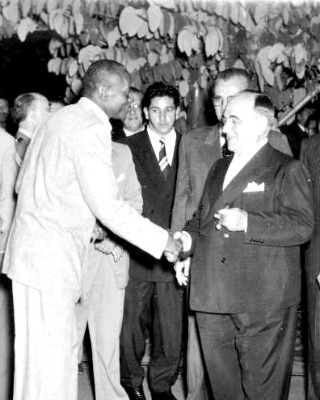 Manuel dos Reis Machado or Mesta Bimba as he was better known was born on 23 November 1900 in Salvador, in the home country of capoeira, Brazil. The youngest of twenty-five children, his first job was as a carpenter on the docks where he developed his physical strength and by the time he was 18, he could carry 120 kg. He learned traditional capoeira (known as Angola) from a Mestre called Betinho and went on to teach it for ten years before he developed his own style, which he called Regional capoeira.
Manuel dos Reis Machado or Mesta Bimba as he was better known was born on 23 November 1900 in Salvador, in the home country of capoeira, Brazil. The youngest of twenty-five children, his first job was as a carpenter on the docks where he developed his physical strength and by the time he was 18, he could carry 120 kg. He learned traditional capoeira (known as Angola) from a Mestre called Betinho and went on to teach it for ten years before he developed his own style, which he called Regional capoeira.Regional Capoeira’s Code of Ethics
Previously, it was said that every capoeirista had his own style but Mestre Bimba brought in a training system that consolidated the techniques and refined the art. He also recognised that like other world martial arts, capoeira needed a code of ethics before its reputation could be restored and it could get accepted by people outside the criminal underworld as a part of Brazilian heritage. The honour code developed for Regional capoeira included rules such as:- No smoking or drinking alcohol.
- Skills should only be demonstrated inside the roda, allowing for the element of surprise should a real fight situation occur. (The roda is a circle formed by people, inside which, practice fights take place)
- When training, the capoeira fighter should focus on the task at hand.
- Talking in the roda should be kept to a minimum
- Other ‘players’ should be watched in a bid to learn more. (In capoeira the term ‘player’ is deemed correct, unlike in many other martial arts).
- The ginga (the fundamental move in capoeira shown being taught by Bimba below) and other basic capoeira moves should be practised as often as possible.
- Do not be afraid to get close to your fighting opponent as the more you do this, the more you will learn.
- The capoeira fighter’s body should be kept relaxed.
- It is better to be defeated in the roda than in a real fight situation.
Other Developments Made by Mestre Bimba
Practitioners of the Mestre’s Regional capoeira were (and still are) also expected to be presentable at all times and wear clean, white uniforms with coloured scarfs that indicate rank. He also included choreographed sets of moves and introduced flips, throws and sweeps to the fighting system, giving it its characteristic flamboyancy that sets it apart from the other main type of capoeira of Brazil, the Angola style.
During his early years, being a capoeira fighter was outlawed which made many of the best martial arts experts criminals. Nonetheless, Bimba was known to openly learn and teach capoeira and by around 1928, he was well respected enough to be asked to demonstrate it in front of the President of Brazil, Getulio Vargas (pictured together above).
After witnessing Mestre Bimba’s demonstration, the President was so impressed he made one of the most important decisions in capoeira history and authorized the opening of the first legal capoeira school in 1932 which Bimba named Centro de Cultura Fisica Regional (CCFR). It was a place where people from all walks of life could go and learn the martial art and this act at once gave capoeira an air of respectability in the public eye and changed its image forever.
After a demonstration of Regional capoeira in 1974, the mestre was taken to a hospital in Goiania after complaining he felt sick. Soon after, at the age of 74, one of the most significant men in capoeira history died of a brain haemorrhage. His legacy is still felt strongly today in the art and Mestre Bimba is unarguably one of the most influential people in the history of the martial arts in Brazil.
O Malandro and Crime. [Internet]. 2012. Rensselaer Polytechnic Institute. Available from: http://capoeira.union.rpi.edu/history.php?chapter=Malandro [Accessed October 24, 2013].
Protetor, B. [Internet]. 2010. About Capoeira – History. Origens do Brasil. Available from: http://www.origensdobrasil.co.uk/history.php [Accessed October 24, 2013].
The Owner of the Game: Mestre Bimba. [Internet]. 2002. University of Florida. Available from: http://iml.jou.ufl.edu/projects/fall02/oliveira/regional.html [Accessed October 24, 2013].
During his early years, being a capoeira fighter was outlawed which made many of the best martial arts experts criminals. Nonetheless, Bimba was known to openly learn and teach capoeira and by around 1928, he was well respected enough to be asked to demonstrate it in front of the President of Brazil, Getulio Vargas (pictured together above).
After witnessing Mestre Bimba’s demonstration, the President was so impressed he made one of the most important decisions in capoeira history and authorized the opening of the first legal capoeira school in 1932 which Bimba named Centro de Cultura Fisica Regional (CCFR). It was a place where people from all walks of life could go and learn the martial art and this act at once gave capoeira an air of respectability in the public eye and changed its image forever.
After a demonstration of Regional capoeira in 1974, the mestre was taken to a hospital in Goiania after complaining he felt sick. Soon after, at the age of 74, one of the most significant men in capoeira history died of a brain haemorrhage. His legacy is still felt strongly today in the art and Mestre Bimba is unarguably one of the most influential people in the history of the martial arts in Brazil.
Written by Andrew Griffiths – Last updated 18/07/2023. If you like
what you see, consider following the History of Fighting on social media.
Further Reading:
Interview with Mestre Bimba. [Internet]. 1973. Originally published in the Goiânia Gazette and reproduced by Capoeira Connection. Available from: http://capoeira-connection.com/capoeira/2012/01/i-challenged-all-the-tough-guys-mestre-bimba-1973/ [Accessed October 24, 2013].O Malandro and Crime. [Internet]. 2012. Rensselaer Polytechnic Institute. Available from: http://capoeira.union.rpi.edu/history.php?chapter=Malandro [Accessed October 24, 2013].
Protetor, B. [Internet]. 2010. About Capoeira – History. Origens do Brasil. Available from: http://www.origensdobrasil.co.uk/history.php [Accessed October 24, 2013].
The Owner of the Game: Mestre Bimba. [Internet]. 2002. University of Florida. Available from: http://iml.jou.ufl.edu/projects/fall02/oliveira/regional.html [Accessed October 24, 2013].
More Capoeira History
Capoeira History Home
An overview of the history of capoeira from its early roots, its development by slaves in Brazil, how it flourished amongst criminals and its further development and legitimisation by Mestre Bimba in the early twentieth century.
An overview of the history of capoeira from its early roots, its development by slaves in Brazil, how it flourished amongst criminals and its further development and legitimisation by Mestre Bimba in the early twentieth century.
The Roots of Capoeira
The exact roots of capoeira are unknown and largely unstudied. This article explores the possible beginnings of capoeira history and looks at how and why it became a part of the culture amongst Brazilian slaves from the sixteenth century onward.
The exact roots of capoeira are unknown and largely unstudied. This article explores the possible beginnings of capoeira history and looks at how and why it became a part of the culture amongst Brazilian slaves from the sixteenth century onward.
Brazil’s Criminal Underworld
From the late 19th century, the criminal underworld of Brazil saw its numbers dramatically rise when slavery legally came to an end in 1888. Many skilled fighters became powerful and as many of them were capoeirista, the martial art became synonymous with criminal gangs.
From the late 19th century, the criminal underworld of Brazil saw its numbers dramatically rise when slavery legally came to an end in 1888. Many skilled fighters became powerful and as many of them were capoeirista, the martial art became synonymous with criminal gangs.
Mestre Manduca da Praia – The Elegant Capoeira Fighter
Mestre Manduca da Praia, known as ‘The Elegant Capoeira Fighter’ was a nineteenth century Brazilian martial artist who was not only a ferocious warrior, but managed to maintain his standing as a respectable business man with in his community.
Mestre Manduca da Praia, known as ‘The Elegant Capoeira Fighter’ was a nineteenth century Brazilian martial artist who was not only a ferocious warrior, but managed to maintain his standing as a respectable business man with in his community.
Jose Antonio do Nascimento
Jose Antonio do Nascimento was one of the best fighters of the nineteenth century. His skills earned him a fearsome reputation and his size and prowess earned him the nickname Nascimento Grande (Big Birth).
Jose Antonio do Nascimento was one of the best fighters of the nineteenth century. His skills earned him a fearsome reputation and his size and prowess earned him the nickname Nascimento Grande (Big Birth).
Mestre Besouro Manganga
Besouro Manganga was such a prolific capoeira fighter that people believed him to have magical powers (known as corpo fechado). His agility and nimbleness helped him avoid capture time and time again, and even when cornered by police, he would usually come out on top.
Besouro Manganga was such a prolific capoeira fighter that people believed him to have magical powers (known as corpo fechado). His agility and nimbleness helped him avoid capture time and time again, and even when cornered by police, he would usually come out on top.
Angola Capoeira
The Angola style of capoeira is one of the two main systems of the art and was introduced in 1942 by Mestre Pastinha. Unlike the other style, Regional capoeira, it focuses the individual development of each capoeirista as opposed to practicing set sequences and training methods and is more akin to the type of capoeira practiced prior to the 20th century.
The Angola style of capoeira is one of the two main systems of the art and was introduced in 1942 by Mestre Pastinha. Unlike the other style, Regional capoeira, it focuses the individual development of each capoeirista as opposed to practicing set sequences and training methods and is more akin to the type of capoeira practiced prior to the 20th century.
The images on this site are believed to be in the public domain, however, if any mistakes have been made and your copyright or intellectual rights have been breeched, please contact andrew@articlesonhistory.com.

